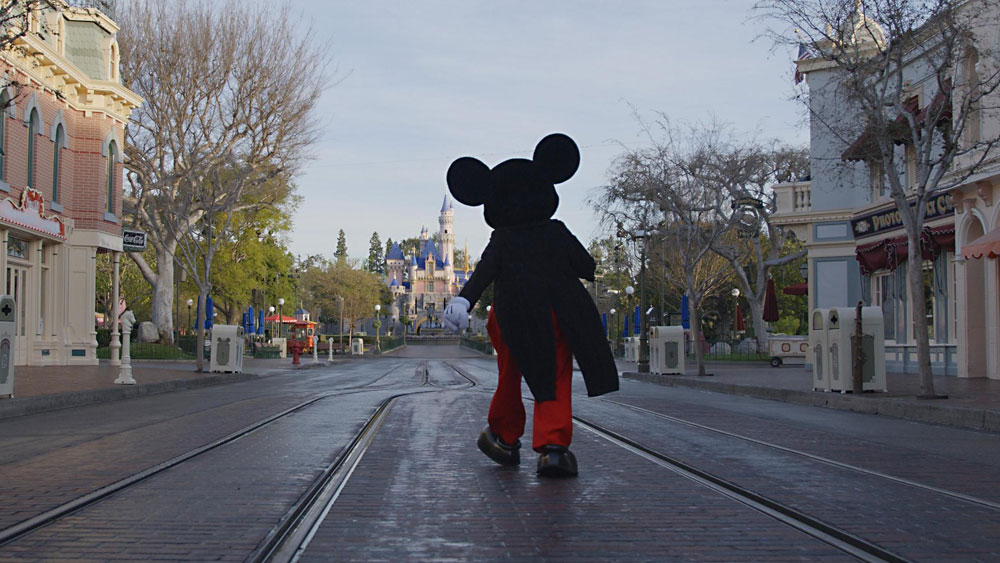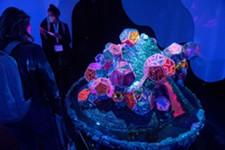Mickey: The Story of a Mouse Is a Tale of Perseverance
The mouse in everyone's house
By Richard Whittaker, Fri., March 11, 2022
Three circles – two small, perched on one large. The silhouette of Mickey Mouse is one of the most instantly recognizable images in the world. “I just walked around the lake,” said Jeff Malmberg, “and I saw Mickey three times. There is not a day when I don’t walk out of the house and see that image, and I can’t say that about any other image.”
The filmmaker explores how that friendly array of curves with the high-pitched voice has become a defining part of global culture in Mickey: The Story of a Mouse, which receives its world premiere at this year’s South by Southwest Film Festival. Yet, at first glance, Malmberg may not seem like the most obvious pick to make a documentary about the beloved cartoon character-turned-corporate mascot. His 2010 SXSW Grand Jury prize winner, Marwencol, was a sympathetic look at one man’s art therapy through a world of dolls. His 2017 follow-up, Spettacolo, took the stage of a small Italian town’s amateur theatre. “I’m attracted to the idea that creativity is valuable, but creativity is hard and difficult and challenging, but it’s worth the effort,” said Malmberg, who was drawn to the happy little rodent for exactly those same reasons. “It was a character, a symbol that I always had a lot of questions about.”
The first thing he told Disney when they approached him was simple: that Mickey “deserved a real documentary. ... It was going to come from a place of respect and admiration, but it had to be honest. Mickey has traveled with us long enough that he has all this inherited history and baggage – which reflects back on us.”
The result is not a filmography of Mickey Mouse but an exploration of a phenomenon. After all, his onscreen appearances are a fraction of who Mickey is, what Disney has done with him – and what they failed to do with him. It seems almost insane to think that Mickey did not make an animated appearance between "The Simple Things" in 1953 and Mickey’s Christmas Carol 30 years later. "Because he represented Walt to the company, he was untouchable, creatively, and I think what happens inside that commercialization and popularity, he stops being this hand-drawn character and starts being a product."As a child of the Seventies, Malmberg said, "Mickey to me was a night light. I had no idea that he had any kind of film career."
Since his debut in 1928’s “Steamboat Willie,” Mickey has been many things: a beloved cartoon character, a brand, a counterculture symbol, an endless parade of merchandise. Malmberg said, “At what point does it stop being a character and starts being a plush toy? I think that’s something that Disney wrestled with.” Moreover, he was an alter ego for Walt Disney himself, who voiced him for 20 years and placed him at the heart of the company. Malmberg said, “In the beginning, they’re operating as partners and looking out for each other, but I think that relationship starts to fray as time goes on, and Walt has other interests.” That’s when the line between Mickey as a character and Mickey as a trademark starts to blur. “Walt uses Mickey for a lot of things, to make a lot of his other dreams happen.”
Yet somehow, under the welter of merchandise and questionable cash-ins, Mickey has endured. For Malmberg, there’s one simple reason. “He’s shorthand for joy.”
Austin Chronicle: Your film reminds me of another Disney historical documentary: Waking Sleeping Beauty, about the animated renaissance. It’s not just the subject material, but the idea that people are pouring their hearts into this work, and it’s not always the straightest track.
Jeff Malmberg: That’s always one thing that I break towards. I don’t know about you, but you always hear from these filmmakers and artists after they’ve made a thing, and it sounds preordained, and it makes me feel like creativity is easy. I find that very distancing. I read these articles, and I go, “Well, that’s not how it is for me. It’s hard. I love it, but it’s showing up every day.”
What it took Walt to make those early Mickey shorts was staggering. We only get into it for a few minutes, but they designed a whole system that had not existed on every level, of man and woman power, to make this happen.
AC: When did the idea to include a new hand-drawn Mickey short, the first in decades, become part of the story?
JM: Very early on. The idea was, OK, if we’re going to make a Mickey film, we should make something, and that was them and me following that lead, which was great. It’s one thing to say, “Oh, yes, it was difficult, there were hundreds of inks and painters,” but to see animators doing it in front of you, I think is as or more telling as that. It’s really showing you that, at the end of the day, this is people trying things, and working hard to find the right solution, and I find that really empowering. ... And to see them working on this Mickey short, it’s as much about erasing as it is about drawing. It’s always about trying things.
AC: Disney doesn’t always seem to know what to do with Mickey as a character, but they really find their way again with Paul Rudish’s 2013 Mickey Mouse shorts. You make the case that Mickey is what America wants to be at any point in time, and this Mickey is flawed but trying.
JM: Audiences don’t appreciate a character who succeeds. Audiences appreciate a character that’s trying. It was fascinating to see those early Mickey shorts, and now the later ones, where Mickey’s this fallible person who you’re actually rooting for.
JM: Perseverance. As a symbol, he’s joy, but as a character he’s someone who will just keep trying to do the right thing by any means necessary, and that’s endearing. You can also argue that the reason he’s a success all over the world is because of Disney. All those things are intertwined, and that’s what was interesting for me in making the film, that you’re not just talking about the creation. It becomes one of the most prominent symbols today. How does a creation become that monetized, and that successful?
AC: What’s really amazing is how emotional the response is to him, and you see that when these kids run up to Mickey in the parks.
JM: That was a big thing for me in deciding to do the film, taking my then-3-year-old daughter to Disneyland, and her response to Mickey. It made me start to wonder, is this just ingrained in us? Where is she getting this information?
AC: It’s genetic memory by now.
JM: Exactly, that’s what I mean. I love [artist Shinique Smith]’s thing in the film that aliens come down and look at all this stuff and go, “Was he your god?” That phenomenon was what was interesting to me. Name another character you could say that about. It’s not even close.
AC: There have been so many different versions of Mickey. Which is your favorite one?
JM: The Fantasia, “Brave Little Tailor,” “[The] Little Whirlwind” era was the one I really responded to. It feels like World War II really interrupts Mickey’s arc, in a way, but that “anything is possible Mickey,” that animation that they call “squash and stretch,” that can so hold your interest. My 7-year-old-daughter can watch that Mickey 70, 80 years later and just feel enthralled.
Documentary Spotlight
Mickey: The Story of a Mouse
World Premiere
Saturday, March 19, noon, Paramount
Online: March 20-21













